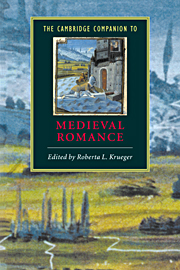Book contents
- Frontmatter
- Introduction
- Part 1 The origins, forms, and contexts of medieval romance
- Part 2 European romance and medieval society
- 5 Courts, clerks, and courtly love
- 6 The societal role of chivalry in romance
- 7 The other worlds of romance
- 8 Questions of gender in Old French courtly romance
- 9 Women and men in late medieval English romance
- Part 3 European transformations
- Editions and translations
- Index
- Series list
7 - The other worlds of romance
from Part 2 - European romance and medieval society
Published online by Cambridge University Press: 28 May 2006
- Frontmatter
- Introduction
- Part 1 The origins, forms, and contexts of medieval romance
- Part 2 European romance and medieval society
- 5 Courts, clerks, and courtly love
- 6 The societal role of chivalry in romance
- 7 The other worlds of romance
- 8 Questions of gender in Old French courtly romance
- 9 Women and men in late medieval English romance
- Part 3 European transformations
- Editions and translations
- Index
- Series list
Summary
An aristocratic society lies at the center of the fictive worlds proposed by most medieval romances. The life of this literary aristocracy may have borne relatively little material resemblance to the lives of its medieval audiences, but it is nonetheless linked in recognizable ways to their interests, longings, ambitions, concerns, and values. And thanks to the significant continuity between medieval literary practices and modern ones, something of this implicit identification between the audience and the aristocratic society at the heart of romance survives for the modern reader. Even we modern readers, that is, sense that the members of the central aristocratic society we encounter in a romance are the protagonists with whom it is assumed we will identify, that the central aristocratic society is in some sense “our” society.
Opposite this central aristocratic society, most medieval romances establish, or assume the existence of, other social “worlds” of various kinds. The members of these other worlds may resemble the members of the central society – they may be as sophisticated, rich, elegant, well-mannered as members of “our” society – but their worlds are nonetheless recognizably different from “ours.” Their motives and customs may be enigmatic or at least strange, and they themselves may be monstrous.
- Type
- Chapter
- Information
- The Cambridge Companion to Medieval Romance , pp. 115 - 131Publisher: Cambridge University PressPrint publication year: 2000
- 6
- Cited by

